Lage rugpijn en lumbosacraal radiculair syndroom [richtlijn]
C.4.1 Mobilisaties en manipulaties
Deze niet-oefentherapeutische interventie valt buiten het competentieprofiel van de oefentherapeut (Cesar/Mensendieck), tenzij de oefentherapeut de aanvullende competenties behaald heeft door middel van scholing.
Overweeg in profiel 2 en 3 mobilisaties [Onder mobilisaties worden verstaan passieve artrogene mobilisaties] en/of manipulaties [Onder manipulaties worden verstaan ‘high-velocity-thrust’-technieken op synoviale gewrichten] uit te voeren bij patiënten met lage rugpijn in aanvulling op oefentherapie indien het probleem mechanisch verklaard kan worden vanuit stoornissen binnen het neuromusculoskeletaal systeem (bijvoorbeeld een verminderde regionale mobiliteit bij lumbale flexie of extensie).
Evalueer en analyseer de effecten van mobilisaties en/of manipulaties direct binnen de behandelsessie en bij aanvang van een volgende sessie. Wees alert op serieuze (zeldzame) nadelige effecten, zoals forse pijntoename, motorische uitval of fracturen.
Bespreek de keuze van mobilisatie of manipulatie met de patiënt en sluit aan bij de behoefte, voorkeuren en mogelijkheden van de patiënt en bij de kennis en vaardigheden van jezelf als therapeut. Besteed hierbij aandacht aan potentiële negatieve effecten en bespreek dit voorafgaand aan de behandeling met de patiënt.
Pas mobilisaties en manipulaties niet toe:
- als enkelvoudige interventie;
- indien je hiertoe niet bekwaam en bevoegd bent of je over onvoldoende kennis beschikt om de indicatiestelling en contra-indicaties te bepalen;
- bij patiënten in profiel 1.
Pas mobilisaties en manipulaties bij voorkeur niet toe bij patiënten met LRS.
Aanleiding
In de ‘KNGF-richtlijn Lage rugpijn’ uit 2013 wordt geadviseerd passieve artrogene mobilisatie of manipulatie te overwegen indien de patiënt een afwijkend beloop heeft van lage rugpijn en dominante psychosociale herstelbelemmerende factoren ontbreken. Bij acute klachten of bij de aanwezigheid van dominante psychosociale herstelbelemmerende factoren worden mobilisaties of manipulaties niet geadviseerd. De aanbevelingen waren gebaseerd op twee systematische literatuuronderzoeken (Dagenais 2010; Rubinstein 2011). Sinds het verschijnen van de vorige richtlijn zijn er diverse nieuwe RCT’s en systematische literatuuronderzoeken verschenen waardoor een update van het literatuuronderzoek gewenst was. Een nadere analyse was mede noodzakelijk, omdat de inclusiecriteria van de twee genoemde literatuuronderzoeken niet geheel overeenkomen met de criteria van de huidige richtlijn. Dagenais en Rubinstein includeerden onder andere RCT’s waarbij de effectiviteit van mobilisaties en manipulaties werd vergeleken met die van medicatie, injecties of alternatieve behandelmethoden. De huidige richtlijn vergelijkt de effectiviteit van mobilisaties en/of manipulaties alleen met die van interventies die passen binnen de richtlijn.
Uitgangsvraag
Worden passieve artrogene mobilisaties en/of manipulaties (‘high-velocity-thrust’-technieken), al dan niet in aanvulling op oefentherapie, aanbevolen voor patiënten met lage rugpijn?
Methode
Voor de beantwoording van deze uitgangvraag is systematisch literatuuronderzoek uitgevoerd en zijn overwegingen in kaart gebracht volgens het GRADE Evidence-to-decision framework (Alonso-Coello 2016ab).
Conclusies op basis van de literatuur
In totaal voldeden 57 RCT’s aan de inclusiecriteria van de huidige richtlijn. De effectiviteit van mobilisaties en/of manipulaties zijn in diverse onderzoeken vergeleken. Daarin werden mobilisaties en/of manipulaties, al dan niet in aanvulling op oefentherapie, vergeleken met interventies die passen binnen de richtlijn, sham-manipulatie, placebo- of geen behandeling. De effecten van mobilisaties en/of manipulaties waren op fysiek functioneren iets groter dan op pijn, maar op beide uitkomstmaten over het algemeen klein, zowel op korte als op lange termijn. In vergelijking met mobilisatie was ook het effect van manipulatie op pijn op korte en lange termijn klein; op functionaliteit was het verschil in effect klinisch-relevant. De bewijskracht conform de GRADE-methodiek varieerde voor alle vergelijkingen tussen zeer laag (9x), laag (10x) en redelijk (1x). Er was geen duidelijk verschil in bewijskracht op korte of lange termijn ten aanzien van pijn of fysiek functioneren.
Hieruit kan worden geconcludeerd dat er beperkt bewijs is voor kleine (niet klinisch-relevante) positieve effecten van mobilisatie/manipulatie al dan niet als toevoeging op oefentherapie, op pijn en fysiek functioneren in vergelijking met andere interventies die binnen de richtlijn passen.
In de volgende tabel zijn de effectiviteit van mobilisaties en/of manipulaties, en de bewijskracht in zes verschillende vergelijkingen samengevat. Alle effecten zijn ten gunste van de interventie.
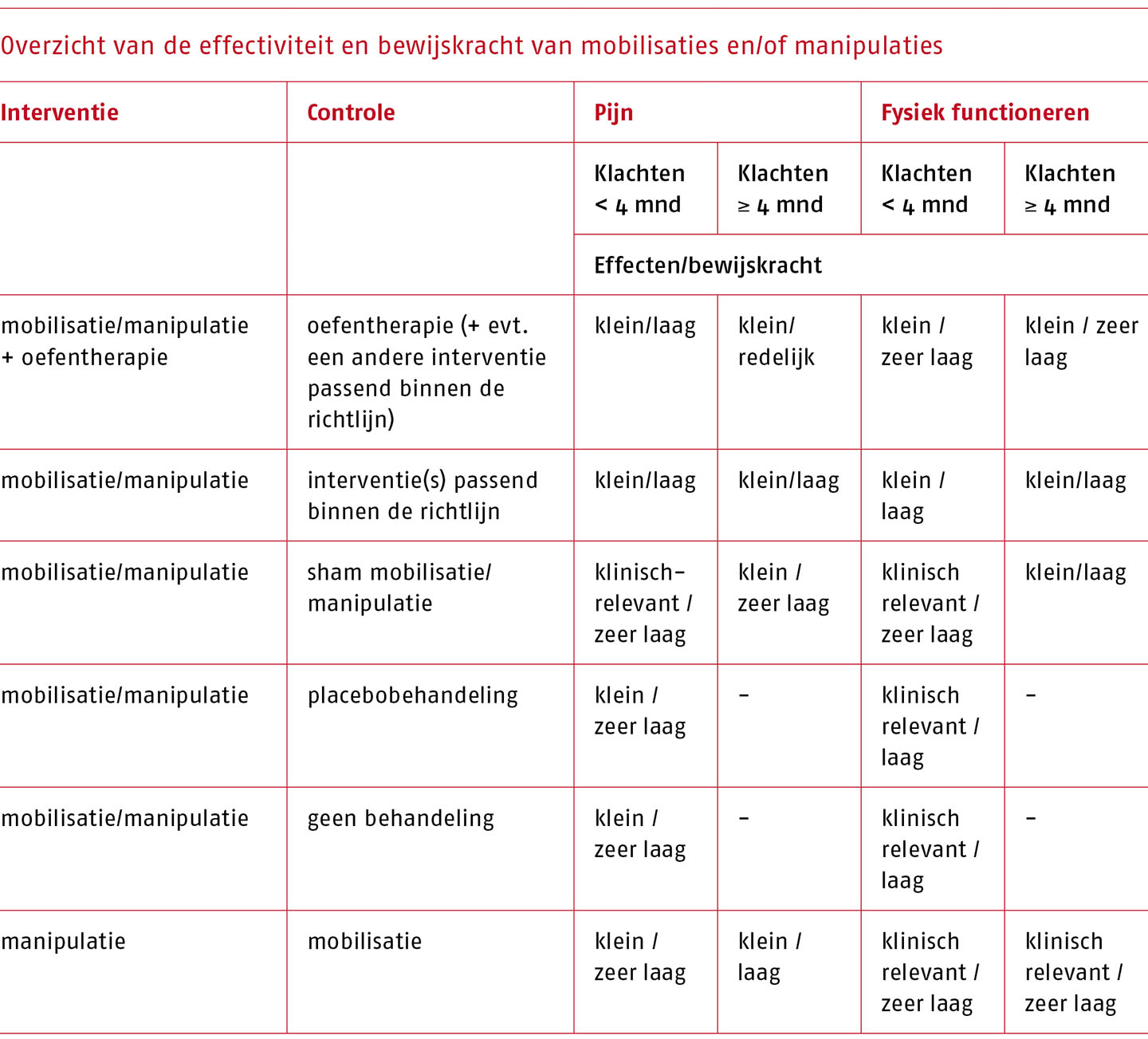
Conclusies op basis van de overwegingen
De werkgroep heeft, ondanks het beperkte bewijs en de kleine effecten van mobilisatie/manipulatie, een aanbeveling geformuleerd voor het overwegen van deze interventie bij patiënten met lage rugpijn indien het probleem mechanisch verklaard kan worden vanuit stoornissen binnen het neuromusculoskeletaal systeem. Stoornissen kunnen bestaan uit verminderde (segmentale of regionale) mobiliteit, een stug/hard eindgevoel, of verhoogde spierspanning (Pool 2014). De werkgroep had hiervoor de volgende argumentatie:
- de ongewenste effecten zijn zelden of nooit ernstig, hoewel uitgebreide informatie hierover beperkt is;
- de resultaten van mobilisatie/manipulatie zijn mogelijk niet suboptimaal onderzocht doordat bijna alle geïncludeerde studies patiënten selecteerden op de aanwezigheid van lage rugpijn zonder daarbij te evalueren of er ook sprake was van stoornissen in het neuromusculoskeletaal systeem;
- in de klinische praktijk zijn de ervaringen met mobilisaties en manipulaties bij patiënten met een bewegingsstoornis binnen het neuromusculoskeletaal domein positief (Pool 2014);
- de resultaten uit het literatuuronderzoek zijn over het algemeen klein, maar alle vergelijkingen zijn ten gunste van mobilisatie/manipulatie;
- recente literatuuronderzoeken concluderen dat mobilisatie/manipulatie mogelijk kosteneffectief is bij patiënten met lage rugpijn.
De werkgroep adviseert de mobilisatie/manipulatie alleen te overwegen als aanvulling op oefentherapie, omdat:
- het accent binnen de richtlijn ligt op een actieve benadering;
- er onduidelijkheid bestaat over de specifieke effecten van mobilisatie/manipulatie; zo is het bewijs dat de effecten van enkelvoudige mobilisatie/manipulatie klinisch-relevant zijn ten opzichte van sham, placebo of geen behandeling laag tot zeer laag;
- mobilisatie/manipulatie als aanvulling op oefentherapie in belangrijke mate aansluit bij de klinische praktijkvoering waarin mobilisaties of manipulaties zelden als unimodale interventie worden toegepast, maar meestal in combinatie met oefeningen en advies;
- er enig bewijs bestaat dat patiënten meer tevreden zijn over de behandeling indien mobilisatie/manipulatie wordt gecombineerd met oefeningen vergeleken met mobilisatie/manipulatie alleen (Bronfort 2001);
- het advies in overeenstemming is met internationale richtlijnen, zoals de Deense richtlijn, de Britse richtlijn van het ‘National Institute for Health and Care Excellence’ (NICE) en de Belgische multidisciplinaire richtlijn van het ‘Belgian Health Care Knowledge Centre’.
Het verschil in effectiviteit tussen manipulatie en mobilisatie is in de huidige richtlijn onderzocht. Manipulatie lijkt effectiever dan mobilisatie op pijn (klein effect) en functionaliteit (klinisch-relevant effect) zowel op korte als lange termijn; de bewijskracht is echter laag tot zeer laag. De werkgroep is van mening dat de beslissing om de patiënt te mobiliseren dan wel te manipuleren over moet worden gelaten aan de specifieke expertise en inschatting van de behandelend therapeut op grond van de lage bewijskracht van de interventies. Alvorens over te gaan tot mobilisatie/manipulatie informeert de therapeut de patiënt over potentiële nadelige effecten van die behandeling.
Duur van de klachten
Bijna alle studies gebruikten duur van de lage rugpijn als criterium om patiënten wel of niet te includeren. Bij de evaluatie van de resultaten waren er echter geen verschillen in behandelresultaten tussen patiënten met kortdurende (< 4 maanden) en aanhoudende lage rugpijn (> 4 maanden). De werkgroep adviseert daarom de beslissing om wel of geen mobilisaties/manipulaties uit te voeren niet te baseren op klachtenduur, omdat bewijs hiervoor ontbreekt.
Locatie van de pijn
De meeste studies includeerden een mix van patiënten met of zonder uitstralende pijn. Doordat er slechts enkele studies waren waarbij uitsluitend patiënten met of juist patiënten zonder uitstralende pijn in het been waren geïncludeerd, was het niet mogelijk verschillen in behandelresultaten voor de verschillende groepen adequaat met elkaar te vergelijken. Er is gebrek aan bewijs voor het effect van mobilisaties en manipulaties bij patiënten met LRS. Daarnaast is er bij patiënten met LRS een grotere kans op bijwerkingen, zowel niet-ernstige als ernstige, zoals forse pijntoename en motorische uitval, ten opzichte van patiënten met lage rugpijn zonder LRS. Op grond hiervan beveelt de werkgroep aan om bij patiënten met LRS mobilisaties en manipulaties bij voorkeur niet toe te passen.
Selectie van patiënten
In bijna alle geïncludeerde studies werden patiënten slechts geselecteerd op de aanwezigheid van lage rugpijn. Mogelijk is pijn echter geen afdoende criterium voor het wel of niet toepassen van mobilisatie en/of manipulatie (Maissan 2018) en zijn er suboptimale behandelresultaten behaald. Ofwel, de kans bestaat dat in dit onderzoek de patiëntkenmerken niet goed aansloten bij het werkingsmechanisme van de behandeling. Er bestaat onduidelijkheid over het exacte werkingsmechanisme van mobilisaties en manipulaties (Bialosky 2018; Mintken 2018). Nader onderzoek is gewenst naar het werkingsmechanisme, maar ook naar de wijze waarop en wanneer mobilisaties/manipulaties worden ingezet in het totale behandelproces.
Kosteneffectiviteit
In vier van de vijf recente systematische literatuuronderzoeken over de kosteneffectiviteit van mobilisaties en manipulaties is enig bewijs gevonden voor de kosteneffectiviteit van mobilisaties en manipulaties alleen of voor deze interventies in combinatie met andere behandelingen (Andronis 2017; Blanchette 2016; Indrakanti 2012; Michaleff 2012; Tsertsvadze 2014). Harper (2017) geeft echter aan dat het moeilijk is definitieve conclusies te trekken vanwege de grote verscheidenheid aan interventiemethoden en controle-interventies, de verschillende perspectieven van waaruit de kosten zijn geïnventariseerd (gezondheidszorg en/of maatschappelijk), de verschillen in uitkomstmaten en de organisatie en bekostiging van zorgstelsels tussen de verschillende landen.
Literatuur
Om de uitgangsvraag te kunnen beantwoorden, is er een systematische literatuuranalyse verricht naar de volgende onderzoeksvraag (PICO):
- Wat zijn de gewenste en ongewenste effecten (O) van manipulatie en/of mobilisatie als aanvulling op oefentherapie (I) versus oefentherapie eventueel in combinatie met een andere controle-interventie zonder manipulatie en/of mobilisatie (C) bij patiënten met lage rugpijn met of zonder uitstraling, zonder belangrijke alarmsymptomen (P)?
- Wat zijn de gewenste en ongewenste effecten (O) van manipulatie en/of mobilisatie (I) versus een controle-interventie zonder manipulatie en/of mobilisatie (C) bij patiënten met lage rugpijn met of zonder uitstraling, zonder belangrijke alarmsymptomen (P)?
- Wat zijn de gewenste en ongewenste effecten (O) van manipulatie (I) versus mobilisatie (C) bij patiënten met lage rugpijn met of zonder uitstraling, zonder belangrijke alarmsymptomen (P)?
Zoekactie
Het literatuuronderzoek is hiërarchisch uitgevoerd; in eerste instantie is gezocht naar bestaande systematische literatuuronderzoeken, eventueel als onderdeel van een evidence-based richtlijn. Op basis van deze zoekactie zijn de volgende bronnen geïdentificeerd: een richtlijn van het ‘National Institute for Health and Care Excellence’ (NICE) (De Campos 2017), de richtlijn van de ‘Danish Health Authority’ (Stochkendahl 2018), een systematische review als voorpublicatie van een Cochrane-review over chronische lage rugpijn (Rubinstein 2019) en een Cochrane-review over acute en subacute lage rugpijn die zich in de afrondende fase bevindt (de Zoete). Zie de volgende tabel.
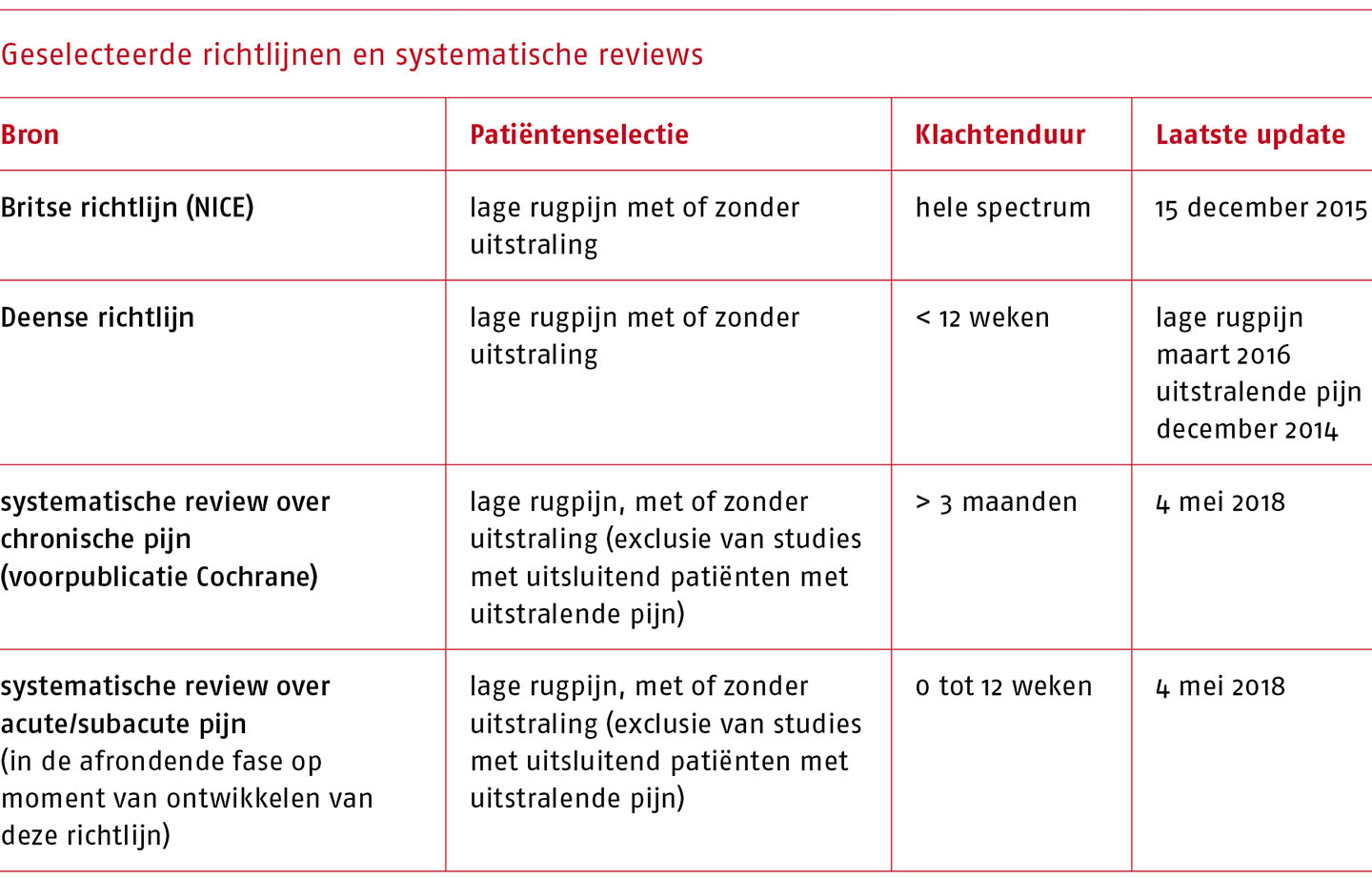
Het literatuuronderzoek van de twee systematische reviews was van recentere datum dan van de twee richtlijnen, maar hadden studies met uitsluitend patiënten met uitstralende pijn geëxcludeerd. In de Britse en Deense richtlijnen werden deze studies wel meegenomen, waardoor deze richtlijnen beter aansloten bij onze zoekactie. Uiteindelijk is ervoor gekozen om de twee reviews als uitgangspunt te hanteren voor de selectie van artikelen en een update van de zoekactie uit te voeren vanaf 1 januari 2018. Tot slot werden de NICE-richtlijn en de Deense richtlijn gescreend op aanvullende literatuur met specifieke aandacht voor studies waarbij uitsluitend patiënten met uitstralende pijn (Eng. ‘sciatica’) waren geselecteerd.
De artikelen uit de twee systematische reviews en de twee richtlijnen zijn getoetst aan de vooraf gedefinieerde inclusiecriteria. Zie de volgende tabel.
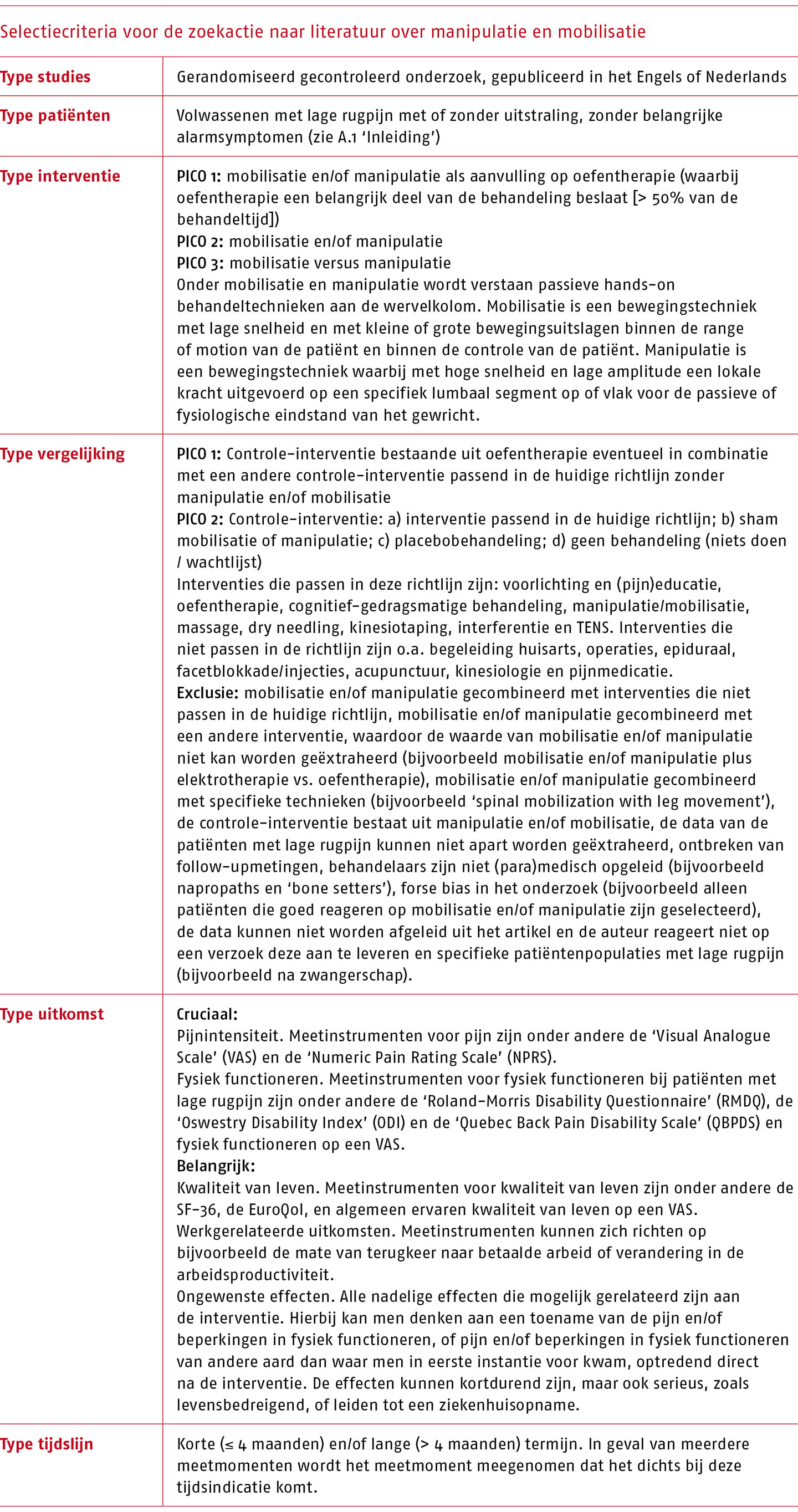
Selectie van studies uit systematische reviews en richtlijnen
De systematische review over patiënten met chronische lage rugpijn (Rubinstein 2019) bevatte 47 RCT’s waarvan er 31 aan onze inclusiecriteria voldeden (Balthazard 2012; Bialosky 2014; Bronfort 2011; Castro-Sánchez 2016; Cecchi 2010; Cook 2013; Dougherty 2014; Ferreira 2007; Ghroubi 2007; Gibson 1985; Goldby 2006; Hidalgo 2015; Hondras 2009; Hsieh 2002; Koes 1992; Krekoukias 2017; Paatelma 2008; Petersen 2011; Pope 1994, Postacchini 1988; Rasmussen-Barr 2003; Rasmussen 2008; Sarker 2016;
Senna 2011; Team 2004; Ulger 2017; Vismara 2012; Waagen 1986; Walker 2013; Waqqar 2016; Xia 2016).
De systematische review over patiënten met acute en subacute lage rugpijn (De Zoete, niet gepubliceerd) bevatte 31 RCT’s waarvan er 17 aan onze inclusiecriteria voldeden (Brennan 2006; Cherkin 1998; Childs 2004; Cleland 2009; Glover 1974; Hadler 1987; Hallegraeff 2009; Hoehler 1981; Hurley 2004; Hussain 2013; MacDonald 1990; Postacchini 1988; Schenk 2012; Seferlis 1998; Shah 2016; Skargren 1997; Wreje 1992). Een artikel was geïncludeerd in beide studies (Postacchini 1988), zodat het totale aantal geselecteerde artikelen uit de twee reviews 47 artikelen bedroeg.
De zoekactie in de NICE-richtlijn leverde vier extra artikelen op (Bronfort 2014; Morton 1999; Santilli 2006; Triano 1995) en een nadere analyse van de Deense richtlijn nul extra artikelen.
Op 4 juni 2020 is door een informatiespecialist (drs. J.W. Schoones, Leids Universitair Medisch Centrum) een systematische zoekactie uitgevoerd in PubMed, MEDLINE, Embase, Emcare, Web of Science en Cochrane Library voor de periode 1 januari 2018 tot 4 juni 2020 (zie bijlage C.4.1-6 voor de zoekverantwoording). De update van de systematische zoekactie leverde 462 unieke treffers op. Na screening van de titel en het abstract op de inclusiecriteria zijn 449 artikelen geëxcludeerd. Van 13 artikelen is het volledige artikel gescreend en bleken zes studies aan onze criteria te voldoen (Alt 2020; De Oliveira Meirelles 2020; Ford 2019; Grande-Alonso 2019; Sarker 2019; Schulz 2019). Zie bijlage C.4.1-1 voor het stroomdiagram van het inclusieproces.
Het totale aantal studies in deze literatuuranalyse komt daarmee uit op 57. Zie bijlage C.4.1-3 voor het stroomdiagram van het inclusieproces. De studies die uit de geactualiseerde zoekactie en de twee systematisch reviews zijn geëxcludeerd, staan vermeld in bijlage C.4.1-2.
Karakteristieken van de geïncludeerde studies
De 57 ingesloten studies includeerden in totaal 8646 patiënten met lage rugpijn, met een mediaan aantal patiënten per studie van 109 (IQR 58-199). De meeste studies includeerden patiënten van middelbare leeftijd (35-60 jaar), met en zonder uitstralende pijn. Vier studies includeerden alleen patiënten met lage rugpijn zonder uitstralende pijn (Dougherty 2014; Ghroubi 2007; Sarker 2019; Shah 2016) en twee studies alleen patiënten met uitstralende pijn (Bronfort 2014; Santilli 2006). In totaal includeerden 37 studies alleen of voornamelijk patiënten met chronische lage rugpijn, 19 studies alleen of voornamelijk patiënten met acute of subacute pijn en één studie includeerde patiënten met acute, subacute en chronische lage rugpijn (Postacchini 1988). De behandelaren in de studies waren fysiotherapeuten of manueel therapeuten (24 studies), chiropractors (16 studies), osteopaten (6 studies), artsen (3 studies) of behandelaren met een andere achtergrond (3 studies). In 5 studies was de achtergrond van de behandelaar onduidelijk.
Individuele studiekwaliteit (RoB)
De kwaliteit van de opzet en uitvoering van de individuele studies (‘risk of bias’, RoB) is beoordeeld volgens de ‘Cochrane Risk-of-Bias tool’ (Higgins 2011). De beoordelingen zijn overgenomen uit de Cochrane-reviews en voor de studies die niet voorkwamen in de twee reviews heeft AA deze beoordeeld. Een overzicht van de beoordeling van de studiekwaliteit (RoB) per studie is weergegeven in bijlage C.4.1-4.
Effectiviteit en bewijskracht van mobilisatie en/of manipulatie plus oefentherapie versus oefentherapie (plus een andere interventie)
Het effect van mobilisatie en/of manipulatie plus oefentherapie op pijn en fysieke beperkingen op korte termijn is in 11 RCT’s (Balthazard 2012; Bronfort 2014; Childs 2004; Grande-Alonso 2019; MacDonald 1990; Morton 1999; Petersen 2011; Rasmussen 2008; Schulz 2019; Team 2004; Vismara 2012) vergeleken met oefentherapie alleen of met het effect van oefentherapie plus een andere binnen de richtlijn passende interventie, en op de lange termijn in zeven RCT’s (Balthazard 2012; Bronfort 2014; Childs 2004; Petersen 2011; Rasmussen 2008; Schulz 2019; Team 2004).
Een overzicht van de resultaten op korte en lange termijn die gepoold konden worden, is weergegeven in de volgende tabellen. Zie bijlage C.4.1-7 figuur 1 t/m 4 voor de forestplots van de cruciale en belangrijke uitkomsten.
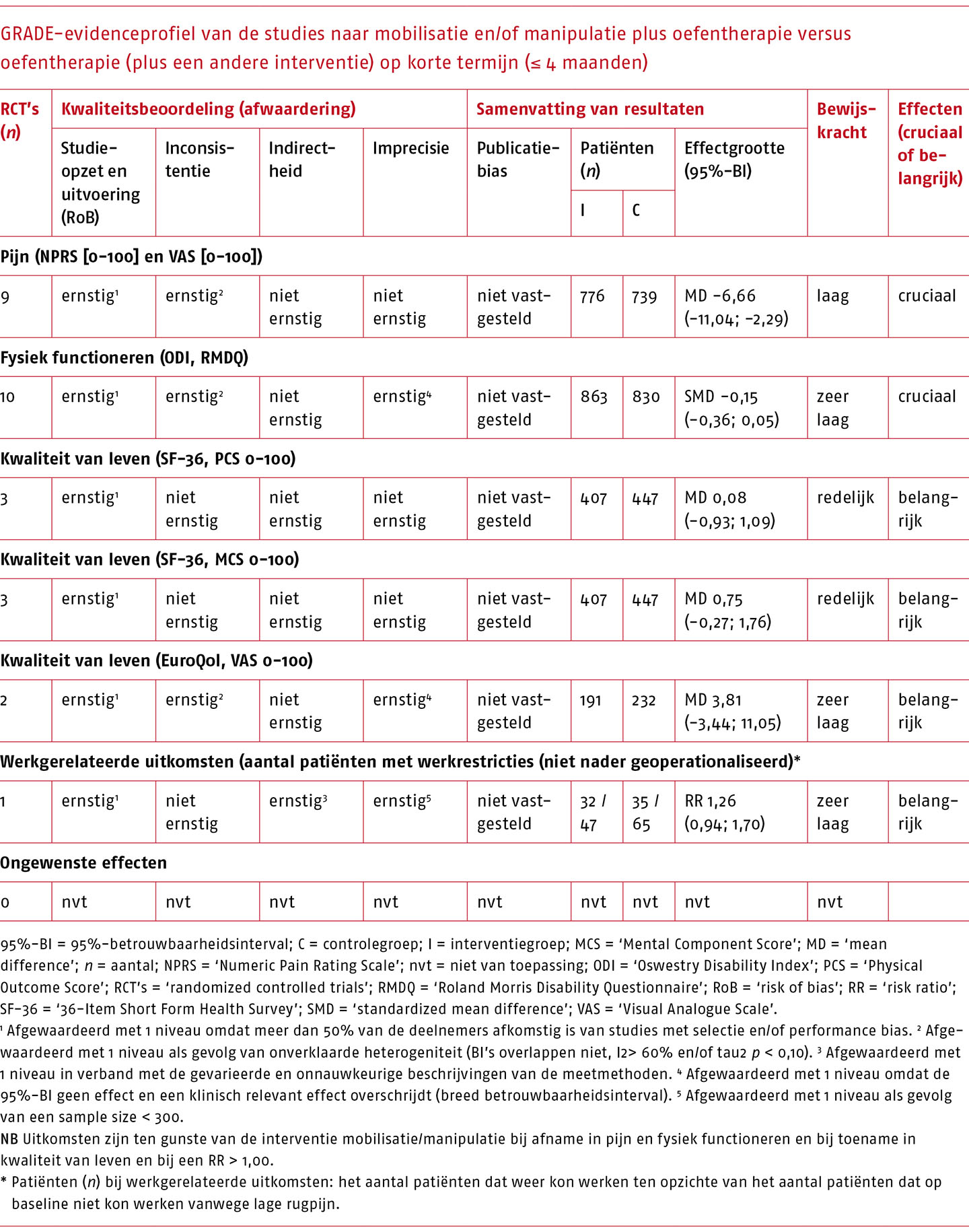
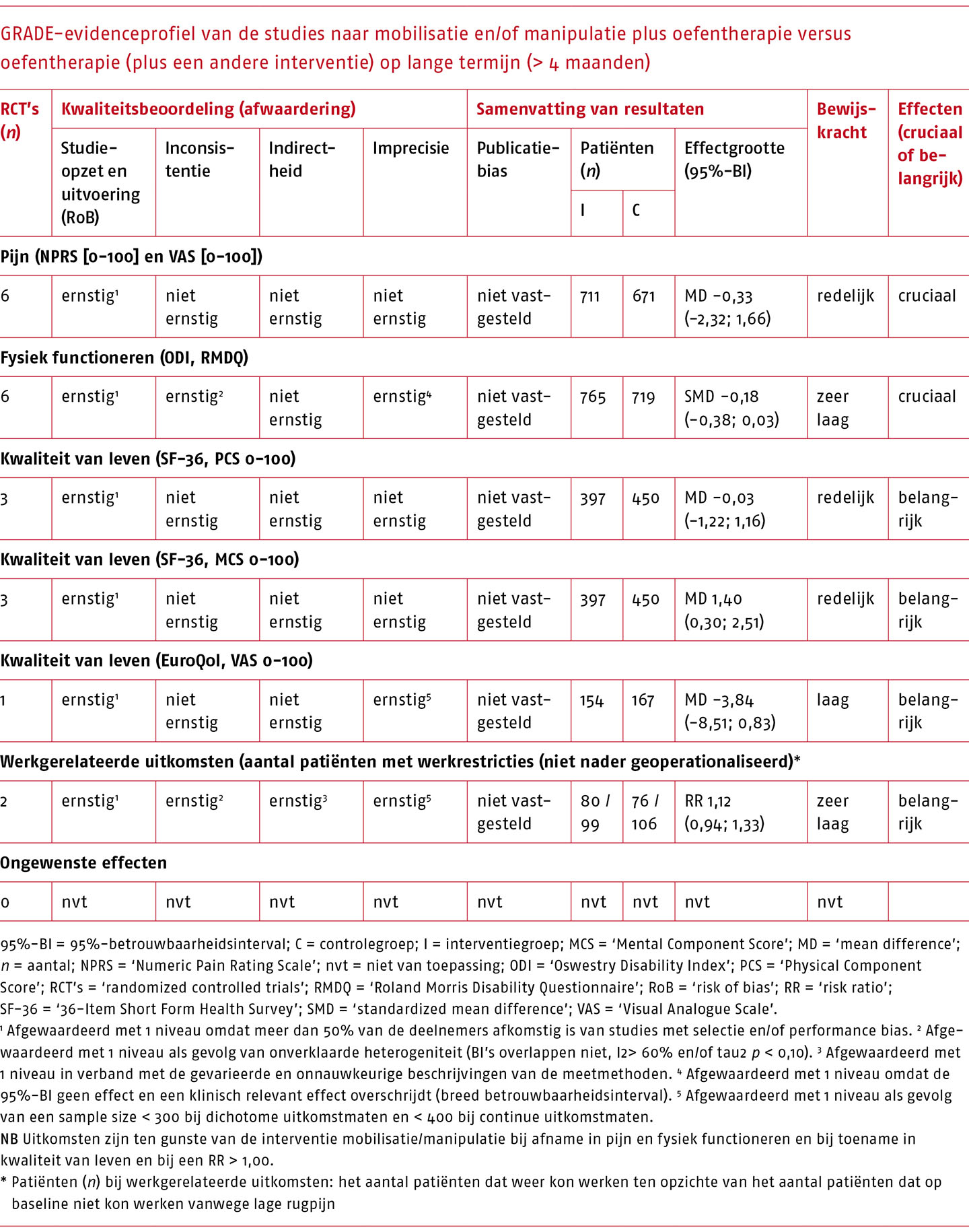
Effectiviteit en bewijskracht van mobilisatie en/of manipulatie versus een andere interventie
Het effect van mobilisatie en/of manipulatie op pijn en fysieke beperkingen op korte termijn is in 21 RCT’s (Brennan 2006; Bronfort 2011; Cecchi 2010; Cherkin 1998; De Oliveira Meirelles 2020; Dougherty 2014; Ferreira 2007; Ford 2019; Hsieh 2002; Hurley 2004; Krekoukias 2017; Paatelma 2008; Rasmussen-Barr 2003; Sarker 2016; Schenk 2012; Shah 2016; Skargren 1997; Team 2004; Triano 1995; Ulger 2017; Waqqar 2016) vergeleken met een andere binnen de richtlijn passende interventie, en op lange termijn in 12 RCT’s (Brennan 2006; Bronfort 2011; Cecchi 2010; Dougherty 2014; Ferreira 2007; Ford 2019; Hsieh 2002; Hurley 2004; Paatelma 2008; Rasmussen-Barr 2003; Skargren 1997; Team 2004).
Een overzicht van de resultaten op korte en lange termijn die gepoold konden worden, is weergegeven in de volgende tabellen. Zie bijlage C.4.1-7 voor de forestplots van de cruciale en belangrijke uitkomsten (figuur 5 t/m 8).
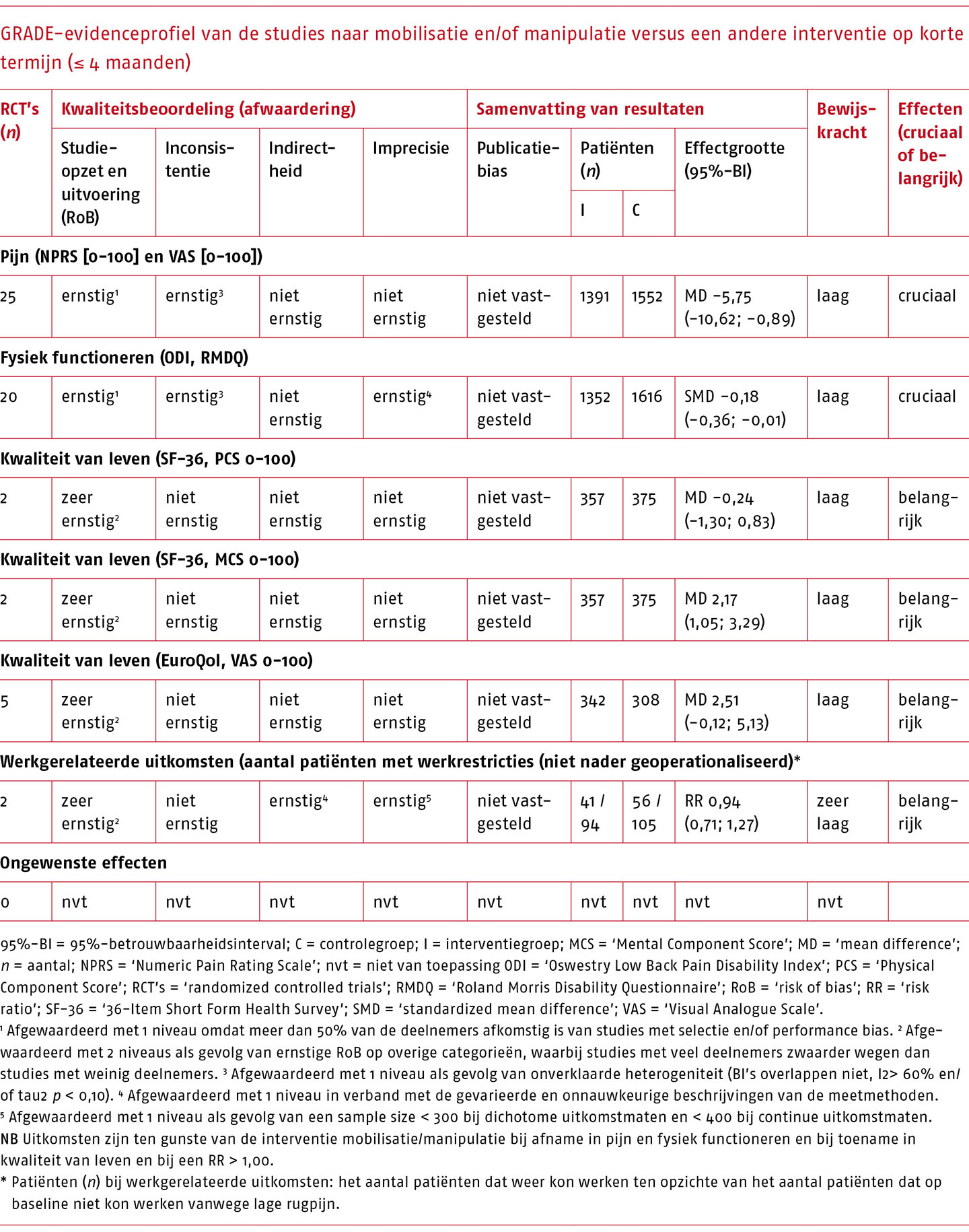
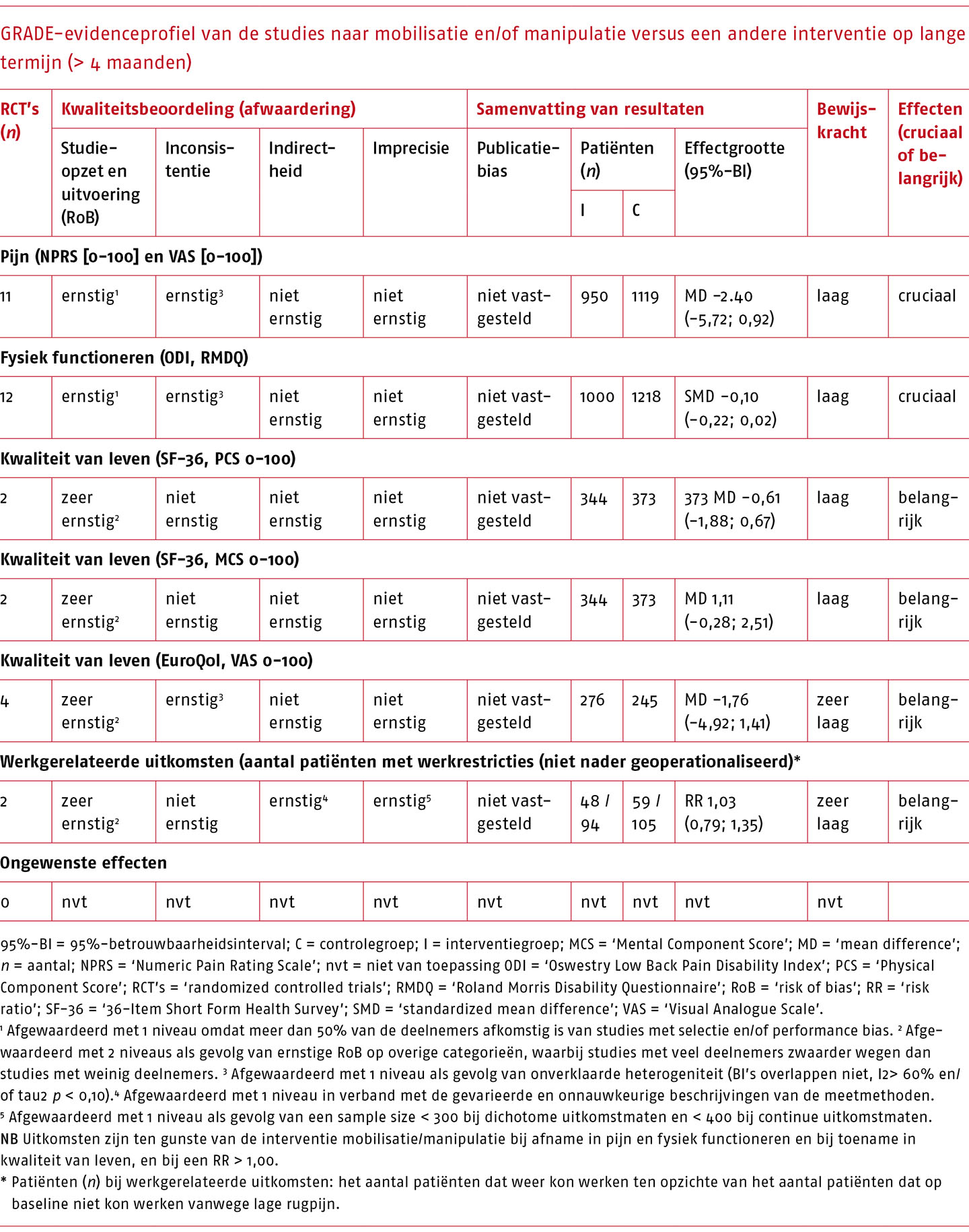
Effectiviteit en bewijskracht van mobilisatie en/of manipulatie versus sham mobilisatie en/of manipulatie
Het effect van mobilisatie en/of manipulatie op pijn en fysieke beperkingen op korte termijn is in 8 RCT’s (Bialosky 2014; Ghroubi 2007; Hidalgo 2015; Krekoukias 2017; Santilli 2006; Senna 2011; Triano 1995; Waagen 1986) vergeleken met sham mobilisatie en/of manipulatie, en op lange termijn in twee RCT’s (Santilli 2006; Senna 2011).
Een overzicht van de resultaten op korte en lange termijn die gepoold konden worden, is weergegeven in de volgende tabellen. Zie bijlage C.4.1-7 voor de forestplots van de cruciale en belangrijke uitkomsten (figuur 9 t/m 11).
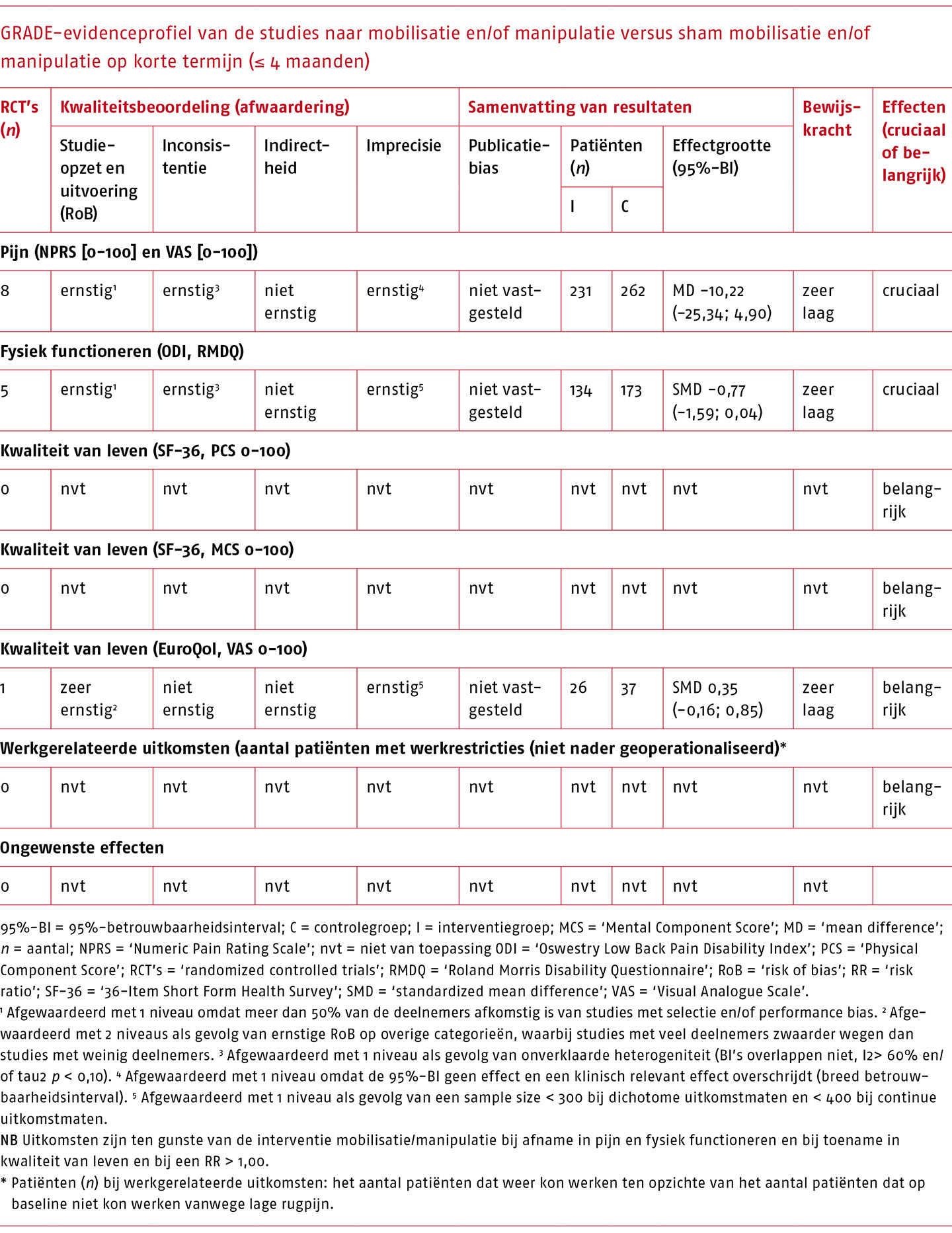
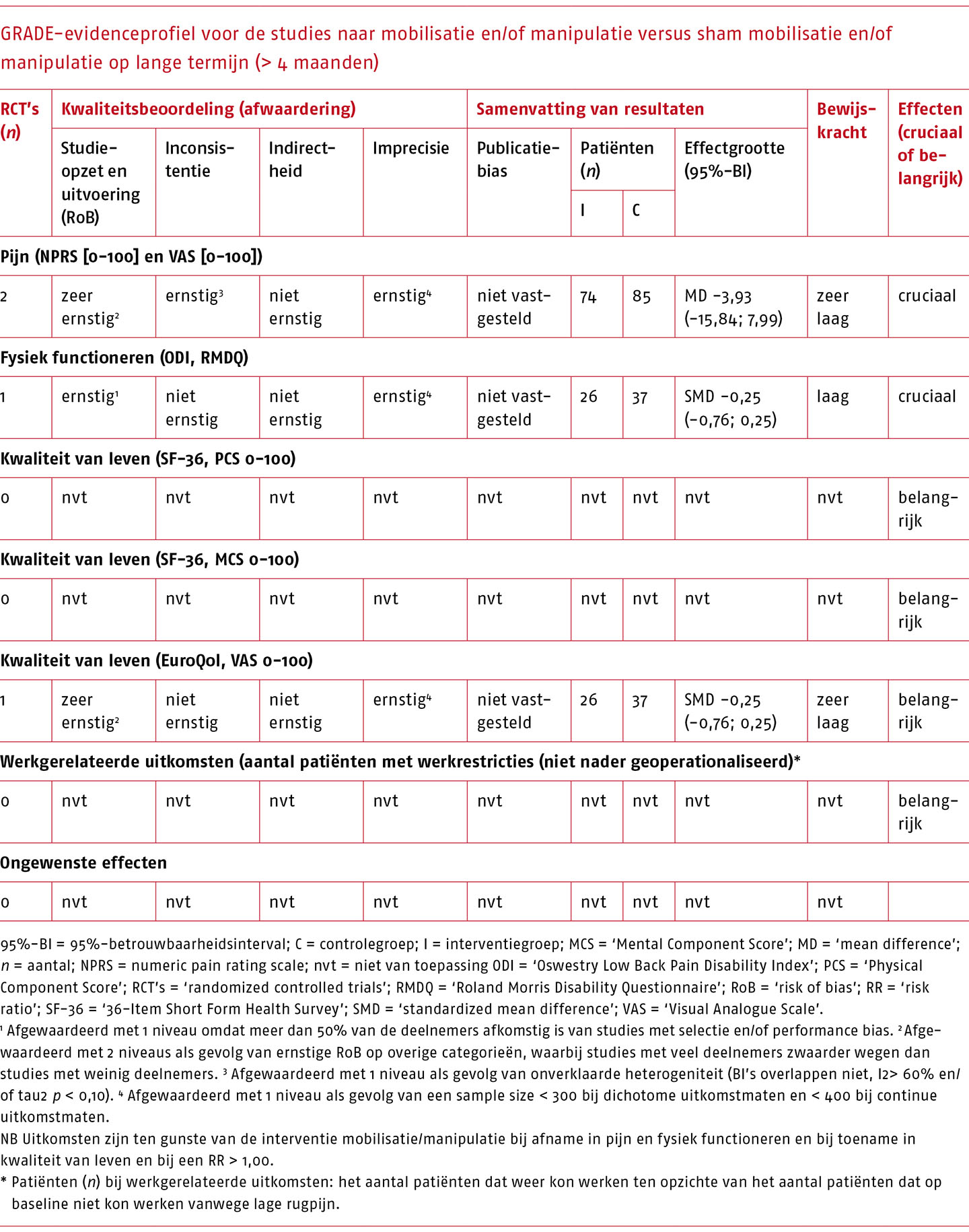
Effectiviteit en bewijskracht van mobilisatie en/of manipulatie versus placebo
Het effect van mobilisatie en/of manipulatie op pijn en fysieke beperkingen op korte termijn is in twee RCT’s (Gibson 1985; Walker 2013) vergeleken met placebo. Er zijn geen RCT’s gevonden die het effect op pijn en/of fysiek functioneren op lange termijn hebben onderzocht.
Een overzicht van de resultaten op korte termijn die gepoold konden worden, is weergegeven in de volgende tabel. Zie bijlage C.4.1-7 voor de forestplots van de cruciale en belangrijke uitkomsten (figuur 12 t/m 14).
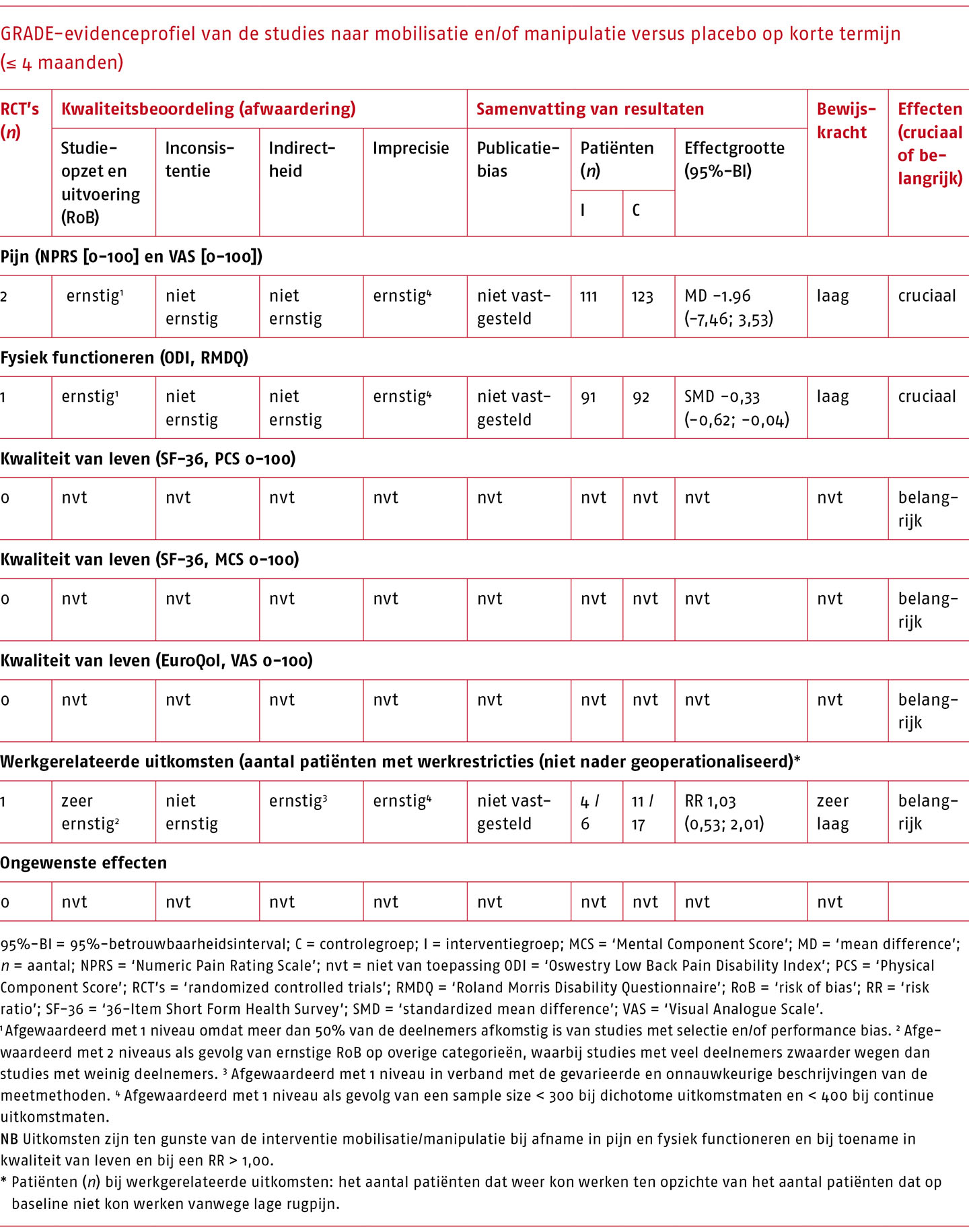
Effectiviteit en bewijskracht van mobilisatie en/of manipulatie versus geen behandeling
Het effect van mobilisatie en/of manipulatie op pijn en fysieke beperkingen op korte termijn is in twee RCT’s (Bialosky 2014; Xia 2016) vergeleken met geen behandeling. Er zijn geen RCT’s gevonden die het effect op pijn en/of fysiek functioneren op lange termijn hebben onderzocht.
Een overzicht van de resultaten op korte termijn die gepoold konden worden, is weergegeven in de volgende tabel. Zie bijlage C.4.1-7 voor de forestplots van de cruciale en belangrijke uitkomsten (figuur 15 t/m 16).
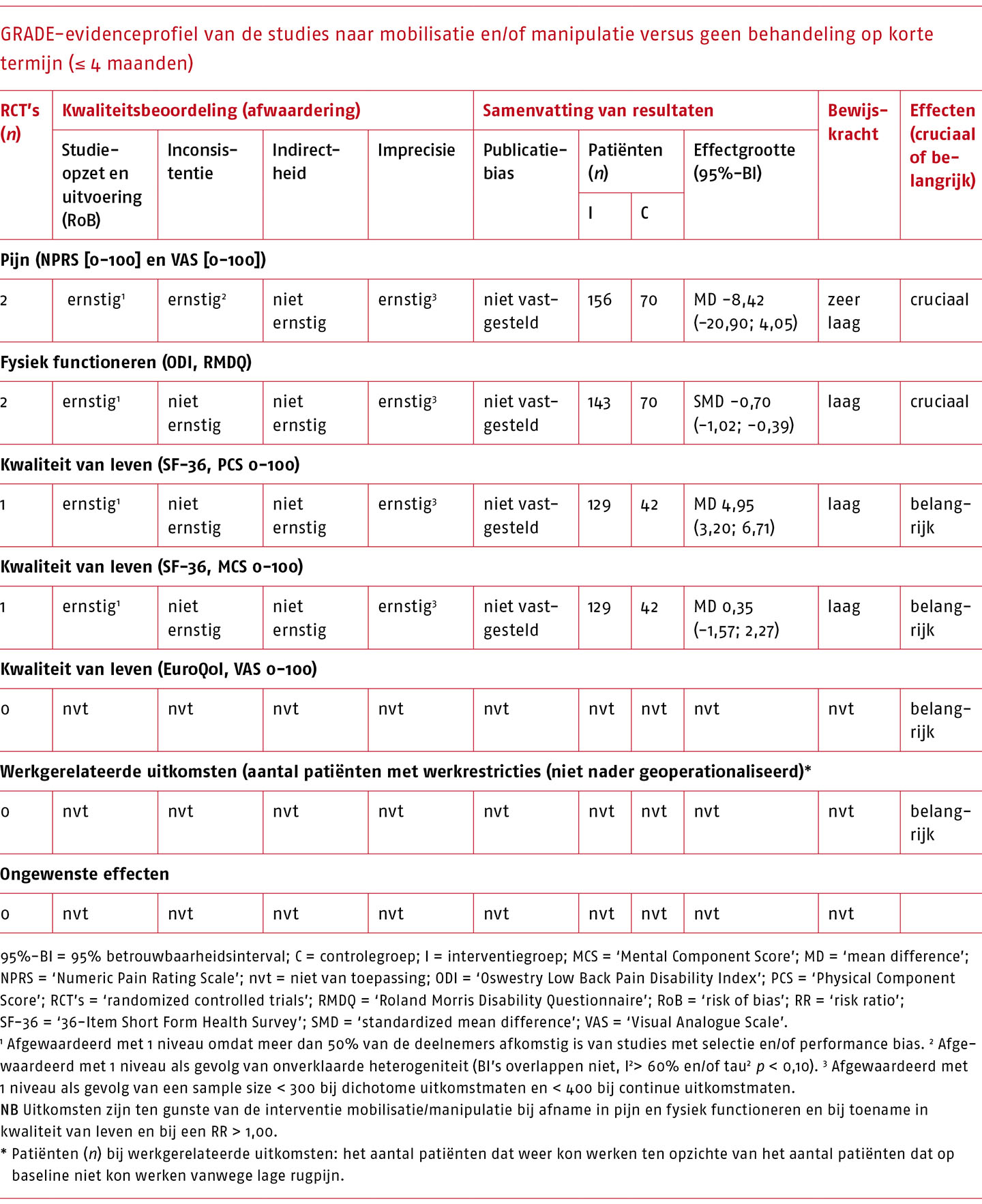
Effectiviteit en bewijskracht van manipulatie versus mobilisatie
Het effect van manipulatie op pijn en fysieke beperkingen op korte termijn is in 6 RCT’s (Castro-Sánchez 2016; Cleland 2009; Cook 2013; Hadler 1987; Hondras 2009; Xia 2016) vergeleken met mobilisatie, en op lange termijn in twee RCT’s (Cleland 2009; Hondras 2009).
Een overzicht van de resultaten op korte en lange termijn die gepoold konden worden, is weergegeven in de volgende tabellen. Zie bijlage C.4.1-7 voor de forestplots van de cruciale en belangrijke uitkomsten (figuur 17 t/m 20).
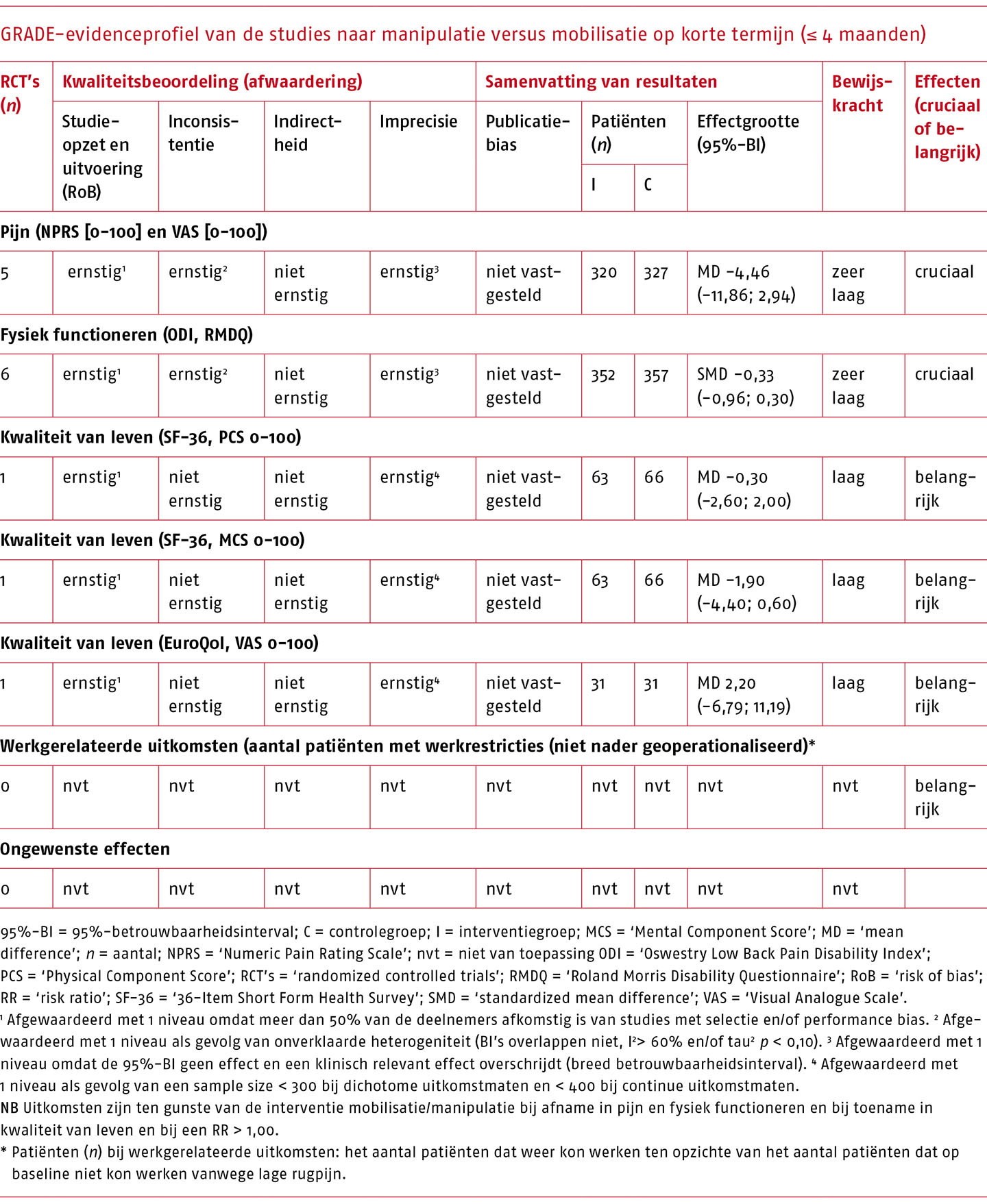
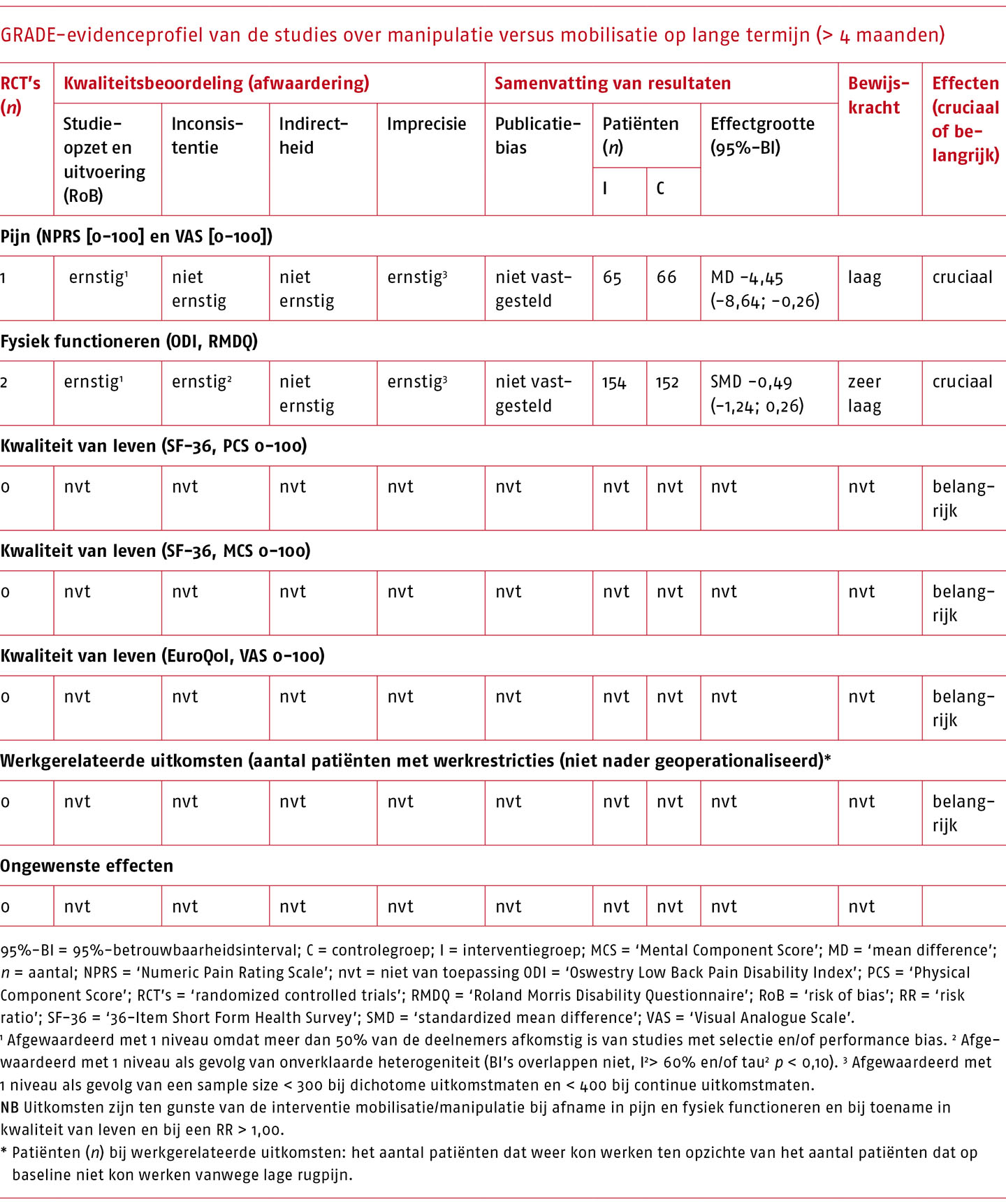
Overwegingen
Voor de beantwoording van de uitgangsvraag worden in het proces van literatuur naar aanbeveling behalve de literatuur ook andere overwegingen meegenomen. Samen bepalen zij de richting en sterkte van de aanbeveling. De beoordeling van overwegingen en de toelichting worden weergegeven in bijlage C.4.1-5.
- Alonso-Coello P, Oxman AD, Moberg J, Brignardello-Petersen R, Akl EA, Davoli M, Treweek S, Mustafa RA, Vandvik PO, Meerpohl J, Guyatt GH, Schunemann HJ, Group GW. GRADE evidence to decision (EtD) frameworks: a systematic and transparent approach to making well informed healthcare choices. 2: Clinical practice guidelines. BMJ. 2016a;353:i2089.
- Alonso-Coello P, Schunemann HJ, Moberg J, Brignardello-Petersen R, Akl EA, Davoli M, Treweek S, Mustafa RA, Rada G, Rosenbaum S, Morelli A, Guyatt GH, Oxman AD, Group GW. GRADE Evidence to Decision (EtD) frameworks: a systematic and transparent approach to making well informed healthcare choices. 1: Introduction. BMJ. 2016b;353:i2016.
- Alt A, Malcherek N, Geisler S, Thietje R. The sustainable effectiveness to avoid chronification in non-specific, non-chronic back pain. Deutsche Zeitschrift fur Sportmedizin. 2020;71(4):97-102.
- Andronis L, Kinghorn P, Qiao S, Whitehurst DG, Durrell S, McLeod H. Cost-effectiveness of non-invasive and non-pharmacological interventions for low back pain: a systematic literature review. Appl Health Econ Health Policy. 2017;15(2):173-201.
- Aspinall SL, Jacques A, Leboeuf-Yde C, Etherington SJ, Walker BF. No difference in pressure pain threshold and temporal summation after lumbar spinal manipulation compared to sham: A randomised controlled trial in adults with low back pain. Musculoskelet Sci Pract. 2019;43:18-25.
- Balthazard P, de Goumoens P, Rivier G, Demeulenaere P, Ballabeni P, Dériaz O. Manual therapy followed by specific active exercises versus a placebo followed by specific active exercises on the improvement of functional disability in patients with chronic non specific low back pain: a randomized controlled trial. BMC Musculoskelet Disord. 2012;13:162.
- Bergquist-Ullman M, Larsson U. Acute low back pain in industry. A controlled prospective study with special reference to therapy and confounding factors. Acta Orthop Scand. 1977(170):1-117.
- Bialosky JE, Beneciuk JM, Bishop MD, Coronado RA, Penza CW, Simon CB, George SZ. Unraveling the mechanisms of manual therapy: modeling an approach. J Orthop Sports Phys Ther. 2018;48(1):8-18.
- Bialosky JE, George SZ, Horn ME, Price DD, Staud R, Robinson ME. Spinal manipulative therapy-specific changes in pain sensitivity in individuals with low back pain (NCT01168999). J Pain. 2014;15(2):136-48.
- Blanchette MA, Stochkendahl MJ, Borges da Silva R, Boruff J, Harrison P, Bussières A. Effectiveness and economic evaluation of chiropractic care for the treatment of low back pain: a systematic review of pragmatic studies. PLoS One. 2016;11(8):e0160037.
- Brennan GP, Fritz JM, Hunter SJ, Thackeray A, Delitto A, Erhard RE. Identifying subgroups of patients with acute/subacute ‘nonspecific’ low back pain: results of a randomized clinical trial. Spine. 2006;31(6):623-31.
- Bronfort G, Evans R, Nelson B, Aker PD, Goldsmith CH, Vernon H. A randomized clinical trial of exercise and spinal manipulation for patients with chronic neck pain. Spine. 2001;26(7):788-97; discussion 98-9.
- Bronfort G, Goldsmith CH, Nelson CF, Boline PD, Anderson AV. Trunk exercise combined with spinal manipulative or NSAID therapy for chronic low back pain: a randomized, observer-blinded clinical trial. J Manipulative Physiol Ther. 1996;19(9):570-82.
- Bronfort G, Hondras MA, Schulz CA, Evans RL, Long CR, Grimm R. Spinal manipulation and home exercise with advice for subacute and chronic back-related leg pain: a trial with adaptive allocation. Ann Intern Med. 2014;161(6):381-91.
- Bronfort G, Maiers MJ, Evans RL, Schulz CA, Bracha Y, Svendsen KH, Grimm RH, Jr., Owens EF, Jr., Garvey TA, Transfeldt EE. Supervised exercise, spinal manipulation, and home exercise for chronic low back pain: a randomized clinical trial. Spine. 2011;11(7):585-98.
- Bronfort G. Chiropractic versus general medical treatment of low back pain: A small scale controlled clinical trial. J Chiropract Med. 1989;2:145-50.
- Castro-Sánchez AM, Lara-Palomo IC, Matarán-Peñarrocha GA, Fernández-de-Las-Peñas C, Saavedra-Hernández M, Cleland J, Aguilar-Ferrándiz ME. Short-term effectiveness of spinal manipulative therapy versus functional technique in patients with chronic nonspecific low back pain: a pragmatic randomized controlled trial. Spine. 2016;16(3):302-12.
- Cecchi F, Molino-Lova R, Chiti M, Pasquini G, Paperini A, Conti AA, Macchi C. Spinal manipulation compared with back school and with individually delivered physiotherapy for the treatment of chronic low back pain: a randomized trial with one-year follow-up. Clin Rehabil. 2010;24(1):26-36.
- Cherkin DC, Deyo RA, Battié M, Street J, Barlow W. A comparison of physical therapy, chiropractic manipulation, and provision of an educational booklet for the treatment of patients with low back pain. N Engl J Med. 1998;339(15):1021-9.
- Childs JD, Fritz JM, Flynn TW, Irrgang JJ, Johnson KK, Majkowski GR, Delitto A. A clinical prediction rule to identify patients with low back pain most likely to benefit from spinal manipulation: a validation study. Ann Intern Med. 2004;141(12):920-8.
- Cholewicki J, Breen A, Popovich JM, Jr., Reeves NP, Sahrmann SA, van Dillen LR, Vleeming A, Hodges PW. Can biomechanics research lead to more effective treatment of low back pain? a point-counterpoint debate. J Orthop Sports Phys Ther. 2019;49(6):425-36.
- Chown M, Whittamore L, Rush M, Allan S, Stott D, Archer M. A prospective study of patients with chronic back pain randomised to group exercise, physiotherapy or osteopathy. Physiotherapy. 2008;94(1):21-8.
- Cleland JA, Fritz JM, Kulig K, Davenport TE, Eberhart S, Magel J, Childs JD. Comparison of the effectiveness of three manual physical therapy techniques in a subgroup of patients with low back pain who satisfy a clinical prediction rule: a randomized clinical trial. Spine. 2009;34(25):2720-9.
- Cook C, Learman K, Showalter C, Kabbaz V, O’Halloran B. Early use of thrust manipulation versus non-thrust manipulation: a randomized clinical trial. Man Ther. 2013;18(3):191-8.
- Cramer GD, Humphreys CR, Hondras MA, McGregor M, Triano JJ. The Hmax/Mmax ratio as an outcome measure for acute low back pain. J Manipulative Physiol Ther. 1993;16(1):7-13.
- Cruser d A, Maurer D, Hensel K, Brown SK, White K, Stoll ST. A randomized, controlled trial of osteopathic manipulative treatment for acute low back pain in active duty military personnel. J Man Manip Ther. 2012;20(1):5-15.
- Dagenais S, Gay RE, Tricco AC, Freeman MD, Mayer JM. NASS contemporary concepts in spine care: spinal manipulation therapy for acute low back pain. Spine. 2010;10(10):918-40.
- de Campos TF. Low back pain and sciatica in over 16s: assessment and management NICE Guideline [NG59]. J Physiother. 2017;63(2):120.
- de Oliveira Meirelles F, de Oliveira Muniz Cunha JC, da Silva EB. Osteopathic manipulation treatment versus therapeutic exercises in patients with chronic nonspecific low back pain: A randomized, controlled and double-blind study. J Back Musculoskelet Rehabil. 2020;33(3):367-77.
- de Zoete A, Verbeeck A, de Boer MR, Assendelft WJJ, van Tulder MW, Rubinstein SM. Spinal manipulative therapy for acute and subacute low back pain. Cochrane Database Syst Rev. Unpublished.
- Dougherty PE, Karuza J, Savino D, Katz P. Evaluation of a modified clinical prediction rule for use with spinal manipulative therapy in patients with chronic low back pain: a randomized clinical trial. Chiropr Man Therap. 2014;22(1):41.
- Evans DP, Burke MS, Lloyd KN, Roberts EE, Roberts GM. Lumbar spinal manipulation on trial. Part I--clinical assessment. Rheumatol Rehabil. 1978;17(1):46-53.
- Farrell JP, Twomey LT. Acute low back pain. Comparison of two conservative treatment approaches. Med J Aust. 1982;1(4):160-4.
- Ferreira ML, Ferreira PH, Latimer J, Herbert RD, Hodges PW, Jennings MD, Maher CG, Refshauge KM. Comparison of general exercise, motor control exercise and spinal manipulative therapy for chronic low back pain: A randomized trial. Pain. 2007;131(1-2):31-7.
- Ford JJ, Slater SL, Richards MC, Surkitt LD, Chan AYP, Taylor NF, Hahne AJ. Individualised manual therapy plus guideline-based advice vs advice alone for people with clinical features of lumbar zygapophyseal joint pain: a randomised controlled trial. Physiotherapy. 2019;105(1):53-64.
- Ghroubi S, Elleuch H, Baklouti S, Elleuch MH. [Chronic low back pain and vertebral manipulation]. Ann Readapt Med Phys. 2007;50(7):570-6.
- Gibson T, Grahame R, Harkness J, Woo P, Blagrave P, Hills R. Controlled comparison of short-wave diathermy treatment with osteopathic treatment in non-specific low back pain. Lancet (London, England). 1985;1(8440):1258-61.
- Glover JR, Morris JG, Khosla T. Back pain: a randomized clinical trial of rotational manipulation of the trunk. Br J Ind Med. 1974;31(1):59-64.
- Goertz CM, Long CR, Hondras MA, Petri R, Delgado R, Lawrence DJ, Owens EF, Meeker WC. Adding chiropractic manipulative therapy to standard medical care for patients with acute low back pain: results of a pragmatic randomized comparative effectiveness study. Spine. 2013;38(8):627-34.
- Goertz CM, Long CR, Vining RD, Pohlman KA, Walter J, Coulter I. Effect of usual medical care plus chiropractic care vs usual medical care alone on pain and disability among us service members with low back pain: a comparative effectiveness clinical trial. JAMA Netw Open. 2018;1(1):e180105.
- Goldby LJ, Moore AP, Doust J, Trew ME. A randomized controlled trial investigating the efficiency of musculoskeletal physiotherapy on chronic low back disorder. Spine. 2006;31(10):1083-93.
- Grande-Alonso M, Suso-Marti L, Cuenca-Martinez F, Pardo-Montero J, Gil-Martinez A, La Touche R. Physiotherapy based on a biobehavioral approach with or without orthopedic manual physical therapy in the treatment of nonspecific chronic low back pain: a randomized controlled trial. Pain Med. 2019;20(12):2571-87.
- Gudavalli MR, Cambron JA, McGregor M, Jedlicka J, Keenum M, Ghanayem AJ, Patwardhan AG. A randomized clinical trial and subgroup analysis to compare flexion-distraction with active exercise for chronic low back pain. Eur Spine J. 2006;15(7):1070-82.
- Haas M, Vavrek D, Peterson D, Polissar N, Neradilek MB. Dose-response and efficacy of spinal manipulation for care of chronic low back pain: a randomized controlled trial. Spine. 2014;14(7):1106-16.
- Hadler NM, Curtis P, Gillings DB, Stinnett S. A benefit of spinal manipulation as adjunctive therapy for acute low-back pain: a stratified controlled trial. Spine. 1987;12(7):702-6.
- Hallegraeff JM, de Greef M, Winters JC, Lucas C. Manipulative therapy and clinical prediction criteria in treatment of acute nonspecific low back pain. [Erratum appears in Percept Mot Skills. 2009 Jun;108(3):981 Note: Hallegraeff, H J M [corrected to Hallegraeff, J M]]. Percept Mot Skills. 2009;108(1):196-208.
- Hancock MJ, Maher CG, Latimer J, McLachlan AJ, Cooper CW, Day RO, Spindler MF, McAuley JH. Assessment of diclofenac or spinal manipulative therapy, or both, in addition to recommended first-line treatment for acute low back pain: a randomised controlled trial. Lancet (London, England). 2007;370(9599):1638-43.
- Harper B, Jagger K, Aron A, Steinbeck L, Stecco A. A commentary review of the cost effectiveness of manual therapies for neck and low back pain. J Bodyw Mov Ther. 2017;21(3):684-91.
- Hemmilä HM, Keinänen-Kiukaanniemi SM, Levoska S, Puska P. Long-term effectiveness of bone-setting, light exercise therapy, and physiotherapy for prolonged back pain: a randomized controlled trial. J Manipulative Physiol Ther. 2002;25(2):99-104.
- Hidalgo B, Pitance L, Hall T, Detrembleur C, Nielens H. Short-term effects of Mulligan mobilization with movement on pain, disability, and kinematic spinal movements in patients with nonspecific low back pain: a randomized placebo-controlled trial. J Manipulative Physiol Ther. 2015;38(6):365-74.
- Higgins JPT, Green S. Cochrane Handbook for Systematic Reviews of Interventions. The Cochrane Collaboration; 2011 [updated March 2011]. Version 5.1.0: Beschikbaar via: www.cochrane-handbook.org. Geraadpleegd op 30 november 2020.
- Hoehler FK, Tobis JS, Buerger AA. Spinal manipulation for low back pain. JAMA. 1981;245(18):1835-8.
- Hoiriis KT, Pfleger B, McDuffie FC, Cotsonis G, Elsangak O, Hinson R, Verzosa GT. A randomized clinical trial comparing chiropractic adjustments to muscle relaxants for subacute low back pain. J Manipulative Physiol Ther. 2004;27(6):388-98.
- Hondras MA, Long CR, Cao Y, Rowell RM, Meeker WC. A randomized controlled trial comparing 2 types of spinal manipulation and minimal conservative medical care for adults 55 years and older with subacute or chronic low back pain. J Manipulative Physiol Ther. 2009;32(5):330-43.
- Hsieh CY, Adams AH, Tobis J, Hong CZ, Danielson C, Platt K, Hoehler F, Reinsch S, Rubel A. Effectiveness of four conservative treatments for subacute low back pain: a randomized clinical trial. Spine. 2002;27(11):1142-8.
- Hurley DA, McDonough SM, Dempster M, Moore AP, Baxter GD. A randomized clinical trial of manipulative therapy and interferential therapy for acute low back pain. Spine. 2004;29(20):2207-16.
- Hurwitz EL, Morgenstern H, Harber P, Kominski GF, Belin TR, Yu F, Adams AH. A randomized trial of medical care with and without physical therapy and chiropractic care with and without physical modalities for patients with low back pain: 6-month follow-up outcomes from the UCLA low back pain study. Spine. 2002;27(20):2193-204.
- Hussain I, Shah SIR, Amjad I. Efficacy of spinal manual therapy in non-specific acute low back pain. RMJ. 2013;38(4):3.
- Indrakanti SS, Weber MH, Takemoto SK, Hu SS, Polly D, Berven SH. Value-based care in the management of spinal disorders: a systematic review of cost-utility analysis. Clin Orthop Relat Res. 2012;470(4):1106-23.
- Koes BW, Bouter LM, van Mameren H, Essers AH, Verstegen GM, Hofhuizen DM, Houben JP, Knipschild PG. The effectiveness of manual therapy, physiotherapy, and treatment by the general practitioner for nonspecific back and neck complaints. A randomized clinical trial. Spine. 1992;17(1):28-35.
- Koninklijk Nederlands Genootschap voor Fysiotherapie (KNGF) / Nederlandse Vereniging voor Manuele Therapie (NVMT). Beroepscompetentieprofiel manueeltherapeut. Amersfoort; KNGF/NVMT; 2014. Beschikbaar via: https://www.kngf.nl/article/vak-en-kwaliteit/beroepscode/beroepsprofiel-fysiotherapeut.
- Krekoukias G, Gelalis ID, Xenakis T, Gioftsos G, Dimitriadis Z, Sakellari V. Spinal mobilization vs conventional physiotherapy in the management of chronic low back pain due to spinal disk degeneration: a randomized controlled trial. J Man Manip Ther. 2017;25(2):66-73.
- Lewis J, O’Sullivan P. Is it time to reframe how we care for people with non-traumatic musculoskeletal pain? Br J Sports Med. 2018;52(24):1543-4.
- Licciardone JC, Minotti DE, Gatchel RJ, Kearns CM, Singh KP. Osteopathic manual treatment and ultrasound therapy for chronic low back pain: a randomized controlled trial. Ann Fam Med. 2013;11(2):122-9.
- Licciardone JC, Stoll ST, Fulda KG, Russo DP, Siu J, Winn W, Swift J, Jr. Osteopathic manipulative treatment for chronic low back pain: a randomized controlled trial. Spine. 2003;28(13):1355-62.
- MacDonald RS, Bell CM. An open controlled assessment of osteopathic manipulation in nonspecific low-back pain. Spine. 1990;15(5):364-70.
- Maissan F, Pool J, Stutterheim E, Wittink H, Ostelo R. Clinical reasoning in unimodal interventions in patients with non-specific neck pain in daily physiotherapy practice, a Delphi study. Musculoskelet Sci Pract. 2018;37:8-16.
- Meade TW, Dyer S, Browne W, Townsend J, Frank AO. Low back pain of mechanical origin: randomised comparison of chiropractic and hospital outpatient treatment. BMJ. 1990;300(6737):1431-7.
- Michaleff ZA, Lin CW, Maher CG, van Tulder MW. Spinal manipulation epidemiology: systematic review of cost effectiveness studies. J Electromyogr Kinesiol. 2012;22(5):655-62.
- Mintken PE, Rodeghero J, Cleland JA. Manual therapists - Have you lost that loving feeling?! J Man Manip Ther. 2018;26(2):53-4.
- Mohseni-Bandpei MA, Critchley J, Staunton T, Richardson B. A prospective randomised controlled trial of spinal manipulation and ultrasound in the treatment of chronic low back pain. Physiotherapy. 2006;92(1):34-42.
- Morton JE. Manipulation in the Treatment of Acute Low Back Pain. J Man Manip Ther. 1999;7(4):8.
- Muller R, Giles LG. Long-term follow-up of a randomized clinical trial assessing the efficacy of medication, acupuncture, and spinal manipulation for chronic mechanical spinal pain syndromes. J Manipulative Physiol Ther. 2005;28(1):3-11.
- Nejati P, Safarcherati A, Karimi F. Effectiveness of Exercise Therapy and Manipulation on Sacroiliac Joint Dysfunction: A Randomized Controlled Trial. Pain Physician. 2019;22(1):53-61.
- Paatelma M, Kilpikoski S, Simonen R, Heinonen A, Alen M, Videman T. Orthopaedic manual therapy, McKenzie method or advice only for low back pain in working adults: a randomized controlled trial with one year follow-up. J Rehabil Med. 2008;40(10):858-63.
- Petersen T, Larsen K, Nordsteen J, Olsen S, Fournier G, Jacobsen S. The McKenzie method compared with manipulation when used adjunctive to information and advice in low back pain patients presenting with centralization or peripheralization: a randomized controlled trial. Spine. 2011;36(24):1999-2010.
- Pope MH, Phillips RB, Haugh LD, Hsieh CY, MacDonald L, Haldeman S. A prospective randomized three-week trial of spinal manipulation, transcutaneous muscle stimulation, massage and corset in the treatment of subacute low back pain. Spine. 1994;19(22):2571-7.
- Postacchini F, Facchini M, Palieri P. Efficacy of various forms of conservative treatment in low back pain. Neuro-Orthopedics. 1988:8.
- Rasmussen GG. Manipulation in treatment of low back pain: a randomized clinical trial. Medizin. 1979;1:8-10.
- Rasmussen J, Laetgaard J, Lindecrona AL, Qvistgaard E, Bliddal H. Manipulation does not add to the effect of extension exercises in chronic low-back pain (LBP). A randomized, controlled, double blind study. Joint Bone Spine. 2008;75(6):708-13.
- Rasmussen-Barr E, Nilsson-Wikmar L, Arvidsson I. Stabilizing training compared with manual treatment in sub-acute and chronic low-back pain. Man Ther. 2003;8(4):233-41.
- Rubinstein SM, de Zoete A, van Middelkoop M, Assendelft WJJ, de Boer MR, van Tulder MW. Benefits and harms of spinal manipulative therapy for the treatment of chronic low back pain: systematic review and meta-analysis of randomised controlled trials. BMJ. 2019;364:l689.
- Rubinstein SM, van Middelkoop M, Assendelft WJ, de Boer MR, van Tulder MW. Spinal manipulative therapy for chronic low-back pain. The Cochrane database of systematic reviews. 2011(2):Cd008112.
- Samir SM, Zaky LA, Soliman MO. Mulligan versus Maitland mobilizations in patients with chronic low back dysfunction. 2016;9(6):92-9.
- Santilli V, Beghi E, Finucci S. Chiropractic manipulation in the treatment of acute back pain and sciatica with disc protrusion: a randomized double-blind clinical trial of active and simulated spinal manipulations. Spine. 2006;6(2):131-7.
- Sarker KK, Mohanty U, Sethi J. Effect of spinal manipulation on postural instability in patients wiht non specific low back pain. Int J Pharma Bio Sci. 2016;7(3):8.
- Sarker KK, Sethi J, Mohanty U. Effect of spinal manipulation on pain sensitivity, postural sway, and health-related quality of life among patients with non-specific chronic low back pain: A randomised control trial. Journal of Clinical and Diagnostic Research. 2019;13(2):YC01-YC5.
- Satpute K, Hall T, Bisen R, Lokhande P. The effect of spinal mobilization with leg movement in patients with lumbar radiculopathy-a double-blind randomized controlled trial. Arch Phys Med Rehabil. 2019;100(5):828-36.
- Schaafstra A, Spinnewijn W, Bons S, Borg M, Koes B, Ostelo R, Spijker-Huiges A, Burgers J, Bouma M, Verburg A. NHG-standaard lumbosacraal radiculair syndroom (tweede herziening). Huisarts Wet. 2015;58(6):308-20.
- Schenk R, Dionne C, Simon C, Johnson R. Effectiveness of mechanical diagnosis and therapy in patients with back pain who meet a clinical prediction rule for spinal manipulation. J Man Manip Ther. 2012;20(1):43-9.
- Schneider M, Haas M, Glick R, Stevans J, Landsittel D. Comparison of spinal manipulation methods and usual medical care for acute and subacute low back pain: a randomized clinical trial. Spine. 2015;40(4):209-17.
- Schulz C, Evans R, Maiers M, Schulz K, Leininger B, Bronfort G. Spinal manipulative therapy and exercise for older adults with chronic low back pain: a randomized clinical trial. Chiropr Man Therap. 2019;27:21.
- Seferlis T, Németh G, Carlsson AM, Gillström P. Conservative treatment in patients sick-listed for acute low-back pain: a prospective randomised study with 12 months’ follow-up. Eur Spine J. 1998;7(6):461-70.
- Senna MK, Machaly SA. Does maintained spinal manipulation therapy for chronic nonspecific low back pain result in better long-term outcome? Spine. 2011;36(18):1427-37.
- Shah SG, Kage V. Effect of seven sessions of posterior-to-anterior spinal mobilisation versus prone press-ups in non-specific low back pain - randomized clinical trial. J Clin Diagn Res. 2016;10(3):Yc10-3.
- Skargren EI, Oberg BE, Carlsson PG, Gade M. Cost and effectiveness analysis of chiropractic and physiotherapy treatment for low back and neck pain. Six-month follow-up. Spine. 1997;22(18):2167-77.
- Skillgate E, Vingard E, Alfredsson L. Naprapathic manual therapy or evidence-based care for back and neck pain: a randomized, controlled trial. Clin J Pain. 2007;23(5):431-9.
- Stochkendahl MJ, Kjaer P, Hartvigsen J, Kongsted A, Aaboe J, Andersen M, Andersen MO, Fournier G, Hojgaard B, Jensen MB, Jensen LD, Karbo T, Kirkeskov L, Melbye M, Morsel-Carlsen L, Nordsteen J, Palsson TS, Rasti Z, Silbye PF, Steiness MZ, Tarp S, Vaagholt M. National clinical guidelines for non-surgical treatment of patients with recent onset low back pain or lumbar radiculopathy. Eur Spine J. 2018;27(1):60-75.
- Sutlive TG, Mabry LM, Easterling EJ, Durbin JD, Hanson SL, Wainner RS, Childs JD. Comparison of short-term response to two spinal manipulation techniques for patients with low back pain in a military beneficiary population. Mil Med. 2009;174(7):750-6.
- Team UBT. United Kingdom back pain exercise and manipulation (UK BEAM) randomised trial: cost effectiveness of physical treatments for back pain in primary care. BMJ. 2004;329(7479):1381-5.
- Teychenne M, Lamb KE, Main L, Miller C, Hahne A, Ford J, Rosenbaum S, Belavy D. General strength and conditioning versus motor control with manual therapy for improving depressive symptoms in chronic low back pain: A randomised feasibility trial. PLoS One. 2019;14(8):e0220442.
- Thorn BE, Eyer JC, Van Dyke BP, Torres CA, Burns JW, Kim M, Newman AK, Campbell LC, Anderson B, Block PR, Bobrow BJ, Brooks R, Burton TT, Cheavens JS, DeMonte CM, DeMonte WD, Edwards CS, Jeong M, Mulla MM, Penn T, Smith LJ, Tucker DH. Literacy-adapted cognitive behavioral therapy versus education for chronic pain at low-income clinics: a randomized controlled trial. Ann Int Med. 2018;168(7):471-80.
- Triano JJ, McGregor M, Hondras MA, Brennan PC. Manipulative therapy versus education programs in chronic low back pain. Spine. 1995;20(8):948-55.
- Tsertsvadze A, Clar C, Court R, Clarke A, Mistry H, Sutcliffe P. Cost-effectiveness of manual therapy for the management of musculoskeletal conditions: a systematic review and narrative synthesis of evidence from randomized controlled trials. J Manipulative Physiol Ther. 2014;37(6):343-62.
- Ulger O, Demirel A, Oz M, Tamer S. The effect of manual therapy and exercise in patients with chronic low back pain: Double blind randomized controlled trial. J Back Musculoskelet Rehabil. 2017;30(6):1303-9.
- Verma Y, Goyal M, Narkeesh. Pain, range of motion and back strength in chronic mechanical low back pain before & after lumbar mobilisation. Int J Physioth Res. 2013;3:48-57.
- Vismara L, Cimolin V, Menegoni F, Zaina F, Galli M, Negrini S, Villa V, Capodaglio P. Osteopathic manipulative treatment in obese patients with chronic low back pain: a pilot study. Man Ther. 2012;17(5):451-5.
- von Heymann WJ, Schloemer P, Timm J, Muehlbauer B. Spinal high-velocity low amplitude manipulation in acute nonspecific low back pain: a double-blinded randomized controlled trial in comparison with diclofenac and placebo. Spine. 2013;38(7):540-8.
- Waagen GN, Haldeman S, Cook G, Lopez D, DeBoer KF. Short term trial of chiropractic adjustments for the relief of chronic low back pain. Manual Medicine. 1986;2:5.
- Walker BF, Hebert JJ, Stomski NJ, Losco B, French SD. Short-term usual chiropractic care for spinal pain: a randomized controlled trial. Spine. 2013;38(24):2071-8.
- Waqqar S, Shakil-Ur-Rehman S, Ahmad S. McKenzie treatment versus mulligan sustained natural apophyseal glides for chronic mechanical low back pain. Pak J Med Sci. 2016;32(2):476-9.
- Wilkey A, Gregory M, Byfield D, McCarthy PW. A comparison between chiropractic management and pain clinic management for chronic low-back pain in a national health service outpatient clinic. J Altern Complement Med. 2008;14(5):465-73.
- Wreje U, Nordgren B, Aberg H. Treatment of pelvic joint dysfunction in primary care - a controlled study. Scand J Prim Health Care. 1992;10(4):310-5.
- Xia T, Long CR, Gudavalli MR, Wilder DG, Vining RD, Rowell RM, Reed WR, DeVocht JW, Goertz CM, Owens EF, Jr., Meeker WC. Similar effects of thrust and nonthrust spinal manipulation found in adults with subacute and chronic low back pain: a controlled trial with adaptive allocation. Spine. 2016;41(12):E702-9.
- Zafereo J, Wang-Price S, Roddey T, Brizzolara K. Regional manual therapy and motor control exercise for chronic low back pain: a randomized clinical trial. J Man Manipul Ther. 2018;26(4):193-202.
- Zaproudina N, Hietikko T, Hänninen OO, Airaksinen O. Effectiveness of traditional bone setting in treating chronic low back pain: a randomised pilot trial. Complement Ther Med. 2009;17(1):23-8.
Algemene informatie
Diagnostisch proces
- B.1 Anamnese, lichamelijk onderzoek en rode vlaggen
- B.1.1 Anamnese
- B.1.2 Lichamelijk onderzoek
- B.1.3 Rode vlaggen
- B.2 Indicatiestelling en behandelprofielen
- B.2.1 Classificatiesystemen
- B.3 Meetinstrumenten
